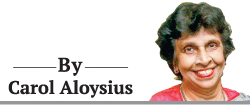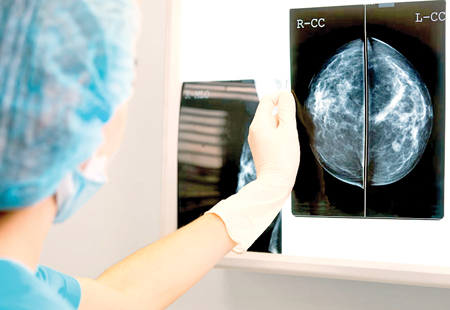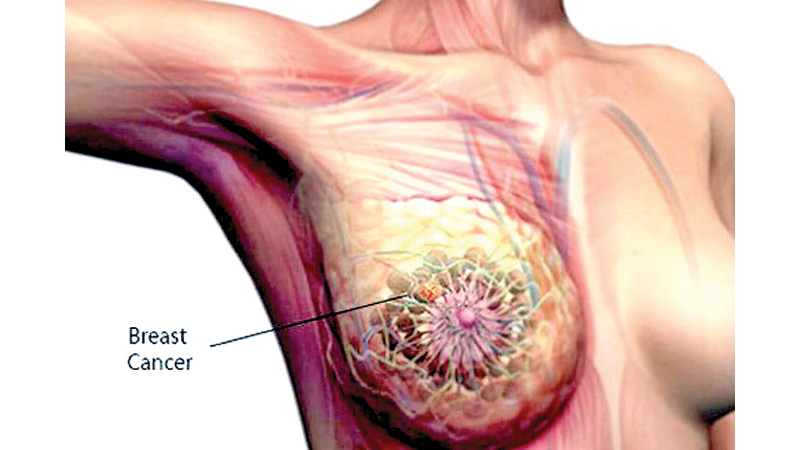 Breast Cancer Awareness Month is being observed from October 1-31. Breast Cancer being one of the most common cancers both globally and in Sri Lanka, the Sunday Observer spoke to Dr. Duminga Rajapakse, Medical Officer, Prevention and Early Detection Unit of the National Cancer Prevention Program (NCCP) to find out the causes, symptoms and most importantly the preventative measures that could be taken to prevent this pervasive and potentially fatal non communicable disease.
Breast Cancer Awareness Month is being observed from October 1-31. Breast Cancer being one of the most common cancers both globally and in Sri Lanka, the Sunday Observer spoke to Dr. Duminga Rajapakse, Medical Officer, Prevention and Early Detection Unit of the National Cancer Prevention Program (NCCP) to find out the causes, symptoms and most importantly the preventative measures that could be taken to prevent this pervasive and potentially fatal non communicable disease.
Q: Many women in Sri Lanka are still ignorant about some of the basic facts of how and what causes breast cancer. So for their benefit and our readers tell us what is Breast Cancer and what are the risk factors that drive this disease?
A: 1. Simply being a female is the greatest risk factor for developing breast cancer, as the disease primarily affects women due to hormonal changes.
2. The risk of breast cancer increases as a woman ages. Most breast cancers are diagnosed in women more than 50 years of age.
3. Previous personal history of breast cancer increases the likelihood of developing it again.
A family history of breast cancer, especially in close relatives like a mother or sister raises the risk, suggesting possible genetic factors (BRCA1 or BRCA2 mutations). However, it was found that only 15 percent of the cases diagnosed with breast cancer had a positive family history.
The following factors mentioned from 4 – 7 are all related to the increased exposure to estrogen hormone which is abundant in the mentioned situations. Therefore, as breast cancer is an estrogen sensitive cancer, all these factors increase the risk of developing it.
4. Nulliparity (Never having given birth):
Women who have never given birth are at a higher risk of developing breast cancer. Pregnancy and breastfeeding offer some protection. Also having the first pregnancy after the age 30 can raise the risk of breast cancer.
5. A prolonged lifetime exposure to estrogen, as seen in Women who experience early menarche (onset of menstruation before the age of 11 years) or late menopause (after the age of 55 years) have a higher risk.
6. Hormone replacement therapy (HRT), especially if used for a long duration after menopause and Long-term use of oral contraceptive pills (OCP) may also slightly increase the risk, although the risk decreases once a woman stops taking the pill.
7. Increased body weight and obesity, especially Post-menopausal weight gain, are significant risk factors. Fat tissue produces estrogen, and higher estrogen levels can promote the development of breast cancer.
8. Smoking and alcohol consumption directly increase the risk of developing breast cancer.
Q: What are the symptoms to watch for?
A: A lump in the breast or underarm area
Pain in breast
Changes in breast shape or size
Redness or swelling in the breast
Nipple discharge, particularly if it is bloody
Retroverted nipple
Dimpling of the skin on the breast or changes in the texture.
Any of these symptoms developed recently is a flag sign you have to be concerned about.
Preventative measures
Although modifications of the above mentioned lifestyle factors could reduce the risk of the disease, breast cancer is often not mentioned as a preventable cancer. But as a cancer which could be completely cured with early intervention. The NCCP promotes :
Regular Self-breast Examinations and advises persons to seek medical advice if they notice any abnormalities.
Clinical-breast examination: In the Sri Lankan setting, we promote Clinical Breast Examination as screening mammography could not be established at the moment.
Maintaining a healthy lifestyle: A balanced diet, regular exercise, and avoiding alcohol and smoking can significantly reduce the risk.
Breastfeeding: Studies have shown that breastfeeding can lower the risk of breast cancer.
Awareness campaigns: The NCCP collaborates with various partners to raise awareness in communities, ensuring that women are educated on risk factors and the importance of early detection.
Q: Are there different types of Breast Cancer? What are the most common type/s you see in Sri Lanka?
A: In Sri Lanka, the most common type of breast cancer is Invasive Ductal Carcinoma (IDC), similar to global trends. This type of cancer begins in the milk ducts and then invades nearby breast tissues.
According to the National Cancer Registry 2021, Infiltrating Duct Carcinoma was the most common type with 1849 detected during that year.
Q: Could these types spread to other parts of the body? If so how?
A: Yes, breast cancer can spread to other parts of the body. This process is called metastasis. Breast cancer can spread beyond the breast tissue to other parts of the body through several pathways:
1.Lymphatic System
Breast cancer cells enter the nearby lymph nodes under the arm (axillary nodes). Once cancer cells enter the lymphatic system, they can travel to other parts of the body too.
2. Bloodstream
When cancerous cells invade nearby blood vessels, they can be carried to distant organs via the bloodstream, a process known as hematogenous spread. Common sites of metastasis through the bloodstream include the lungs, liver, and bones.
3. Local Tissue Invasion
Breast cancer can invade surrounding local tissues, including the skin, chest wall, and muscles around the breast. This is typically seen in more advanced cases.
Q: Why do you need an entire month to raise awareness amid so many other equally pressing health issues facing the health sector?
A: Despite significant advancements in medical care, breast cancer remains one of the most common and potentially fatal cancers affecting women globally and in Sri Lanka. The focus on Breast Cancer Awareness Month allows for concentrated efforts on multiple fronts to address key challenges unique to this disease.
It is also highly treatable if detected early.. A month-long awareness campaign provides enough time to educate people, spread this message widely, and organise screening programs that could save lives. In addition women with the disease often face stigmatisation, by dedicating a month, we can engage communities to destigmatise the disease and foster a culture of support and understanding.
Q: Is Breast feeding by cancer nursing mothers a good thing? What are the main benefits of it to the mother and child?
A: For mothers diagnosed with breast cancer, while there are some limitations during treatment, breastfeeding can still offer valuable advantages, in terms of emotional well-being and bonding with their new born baby. However, it’s important that nursing mothers with breast cancer work closely with their healthcare team to determine when and how breastfeeding is safe during their treatment journey.
While mothers undergoing active breast cancer treatment (such as chemotherapy or radiation) may need to temporarily or permanently stop breastfeeding due to potential risks to the baby, breastfeeding in the early stages or when appropriate can provide health benefits without posing risks. In cases where treatment allows, breastfeeding offers both physical and emotional benefits that can contribute to the mother’s overall well-being and recovery to both the mother and the child.
Q: Gender-wise can males and females get breast cancer? If so which gender is more at risk and why? What is the ratio?
 A: Yes, both males and females can develop breast cancer, but females are at a much higher risk of developing breast cancer than males, due to the significantly higher levels of estrogen and progesterone, which play a critical role in breast tissue development thereby also promoting the growth of breast cancer cells. Statistics wise there are 15 new female breast cancer cases detected every day compared to only 3 new male breast cancers detected every week. Roughly, a woman is 100 times more at risk compared to a man.
A: Yes, both males and females can develop breast cancer, but females are at a much higher risk of developing breast cancer than males, due to the significantly higher levels of estrogen and progesterone, which play a critical role in breast tissue development thereby also promoting the growth of breast cancer cells. Statistics wise there are 15 new female breast cancer cases detected every day compared to only 3 new male breast cancers detected every week. Roughly, a woman is 100 times more at risk compared to a man.
Q: How do you diagnose breast cancer? Via X-rays? Blood tests?
A: Diagnosing breast cancer involves a combination of physical examinations, imaging tests, and laboratory procedures to confirm the presence of cancerous cells and determine the extent of the disease. Usually, a triple assessment is involved in the diagnosis of breast cancer.
1. Physical Examination Clinical Breast Examination
A doctor or healthcare professional performs a physical examination of the breasts to feel for any lumps, irregularities, or changes in size, shape, or texture.
2. Imaging Tests Ultrasound
An ultrasound uses sound waves to produce images of the breast tissue. It is often used to determine whether a breast lump is solid or filled with fluid.
Ultrasound is especially useful in women with dense breast tissue; that is women usually below the age of 50 years.
Mammography is the most common and effective screening tool for detecting breast cancer. It uses X-rays and creates images of the breast tissue which identify abnormalities such as lumps, masses, or calcifications.
3. Biopsy
It is the most reliable way to confirm breast cancer. It involves removing a small sample of breast tissue or cells from the suspicious area for examination under a microscope by a pathologist.
There are several types of biopsies
Fine-Needle Aspiration (FNA): A thin needle is used to extract tissue or fluid from a breast lump.
Core Needle Biopsy: A larger needle is used to remove a core of tissue from the suspicious area.
Surgical Biopsy: In some cases, a small portion of the lump or the entire lump may be surgically removed for analysis.
4. Genetic Testing
BRCA1 and BRCA2 Mutation Testing: Women with a family history of breast cancer or ovarian cancer may undergo genetic testing to determine if they carry mutations in the above genes, which significantly increase the risk of breast cancer.
Q: Are all lumps in the breast cancerous?
A: Not all lumps in the breast are cancerous. In fact, the majority of breast lumps are benign (non-cancerous). While discovering a lump can be alarming, it is important to have any breast lump evaluated by a healthcare professional to determine its nature.
Q: At what age should we consider getting ourselves examined especially if we are vulnerable in either gender?
A: All women above the age of 20 years should start and continue to do monthly self-breast examinations. Clinical breast examination should be done once in every 3 years between the ages 20-40 years and yearly after 40 years.
Q: What are the precautions that the NCCP has set in place recently to reduce risk factors among vulnerable persons especially women?
A: – NCCP Initiatives to Reduce Risk Factors:
Public Awareness Campaigns:
The NCCP conducts awareness programs to educate the public about breast cancer risk factors, the importance of early detection, and healthy lifestyle choices. They include community workshops, seminars, and social media campaigns. This mass awareness campaign is organised by the National Cancer Control Program of the Ministry of Health. The NCCP also offers breast cancer screening programs to encourage regular breast examination.
Q: Treatment-wise what are the options available to women, especially nursing mothers afflicted with breast cancer?
A: Treatment depends on multiple factors such as staging of the disease, general condition of the patient, co-morbidities etc. However, treatment could be surgery, radiotherapy, chemotherapy or combination of them depending on the decision of the treating clinician.
Q: If a woman wants to get herself checked for a suspicious lump in the breast where could she go at minimal cost?
A: Once a woman is detected to have a lump in the breast she can visit a Well Women Clinic, Healthy Lifestyle Centre, Surgical clinic, Breast clinic, Cancer Early Detection Centre free of charge.
Q: There are many myths surrounding Breast cancer. What are the most common in Sri Lanka?
A: 1. Limited awareness of Screening and Early Detection. Inadequate Public Awareness and Education: Misinformation and myths surrounding breast cancer persist, lead to delays in diagnosis and treatment.
Q: Is there a hotline or website that our readers with concerns about breast cancer can access?
A: Our Website is https://www.nccp.health.gov.lk/en




